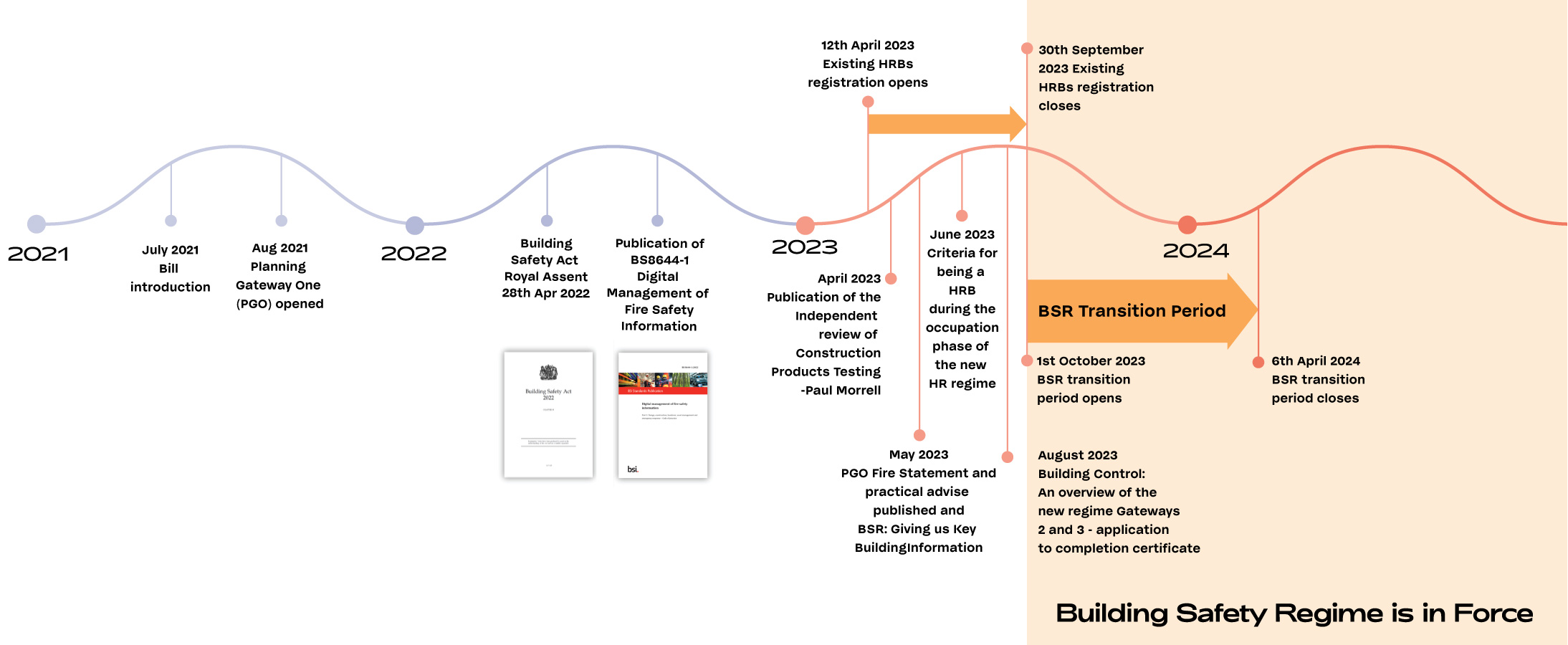The new Building Safety Act received Royal assent in April 2022, and it’s considered the biggest reform to building safety in England and Wales for a generation. While the fundamental standards and regulations have remained largely consistent, it’s the processes surrounding them that are undergoing a significant transformation. The new regime places a paramount emphasis on accountability, transparency, and competency, signaling a bold departure from the status quo.
Scope of the Buildings Safety Act
The Act applies to all buildings but with more stringent requirements for higher-risk buildings. These higher-risk buildings are defined as those that are at least 7 stories tall or 18 meters in height, with at least two residential units.
We will delve into the specific criteria for classifying a building as higher risk in a separate article to provide a deeper understanding.

Phases of Implementing the Buildings Safety Act
As we delve further into the regulatory landscape, it’s crucial to acknowledge the three distinct phases of implementation. We are currently well into Phase 2 – Introduction of Regime and Secondary Legislation. We are rapidly approaching Phase 3 – Transition and coming into force of regime, which commences on the 1st of October 2023. During this phase, the full implementation of the full force of the Building Safety Regime will come into effect. Developers and building owners will be required to adopt a digital standard of record-keeping and establish a framework to exchange design information. These actions are crucial to enabling and contributing to what is referred to as the “Golden Thread” throughout the building’s lifecycle.
This is an important step to secure the safety of people in or about buildings and to improve the standard of buildings.
Transitioning into Phase 3
Phase 3 Transition period – From 1st October 2023 the Building Safety Regulator (BSR) assumes the role of the Building Control Authority for higher-risk buildings. However, there are specific conditions to consider. If an initial notice has been submitted to a local authority (and not rejected), or full plans have been deposited with a local authority (and not rejected) before the 1st October 2023, and if work on site has “sufficiently progressed” then building work can proceed under the oversight of the chosen inspector or local Building Control Authority. If the building work is subject to an initial notice, the approved inspector must register as a building control approver before the end of the transition period (6th April 2024).
Defining “Sufficient Progress”:
The concept of “sufficient progress” holds immense significance. The Higher-risk building (HRB) work/project can be considered to be “sufficiently progressed” when the pouring of concrete for the permanent placement of the trench, pad, or raft foundations, or the permanent placement of piling, for that building, has started, and where the building work consists of work to an existing building, when that work as started, or where the building work consists of a material change of use of a building when work to effect that change of use has started.
Meeting these conditions before the 1st of October 2023 grants building projects the ability to progress without direct involvement from the Building Safety Regulator. Moreover, upon completion, there is no obligatory Gateway 3 submission. Nevertheless, HRBs must be registered with the Building Safety Regulator before occupation can commence. However, if these conditions are not met, the project will be subject to the new building control regime, necessitating the submission of Gateways 2 and 3.
The Building Safety Act is ushering in a new era of building safety in England and Wales, emphasizing accountability, transparency, and competency. As we move closer to the full implementation of the Building Safety Regime, developers and building owners must adapt by embracing digital record-keeping and information exchange. It’s a transformative journey that will ultimately enhance safety, elevate standards, and contribute to the enduring legacy of the Golden Thread of Building Information.
Rui, a seasoned architect with over 15 years of design experience, brings a fervent commitment to both BIM and sustainability to his professional journey. He transitioned to a pivotal role as Head of BIM at a prominent international architectural firm, where he honed his expertise in shaping and executing digital strategies, contributing significantly to the successful delivery of high-profile projects spanning from conception to handover.
With an unwavering dedication to continuous learning, Rui has emerged as a recognized authority on critical topics such as the Building Safety Act and the Golden Thread of information since joining Cohesive. This additional expertise enhances his already robust skill set.
Known for his exceptional leadership and strong interpersonal abilities, Rui is a catalyst for meaningful change. He excels in striking the delicate balance between people, processes, and digital tools, consistently driving progress in pursuit of excellence.

Rui Costa
Business Analyst: Buildings and Communities
Disclaimer: The information provided in this article is for general information only. All information provided here is one person’s interpretation and it cannot be used for legal purposes. Cohesive holds no responsibility and makes no representation or warranty about the accuracy or completeness of this information.








